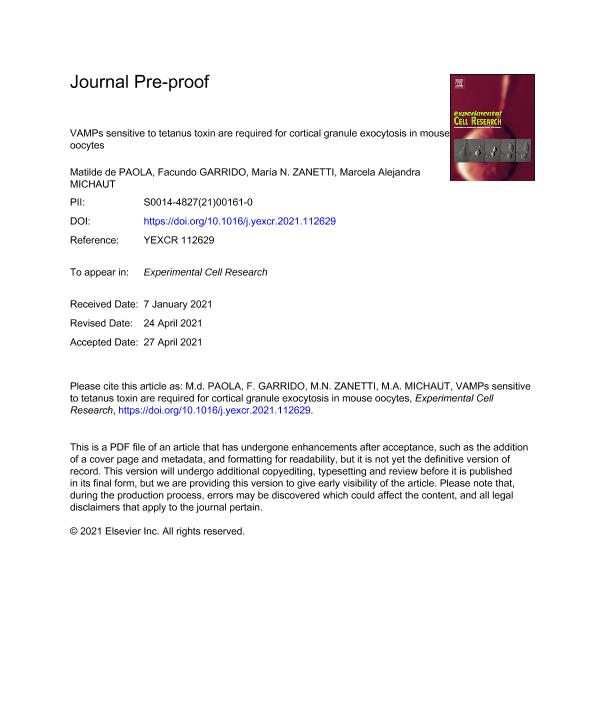Artículo
VAMPs sensitive to tetanus toxin are required for cortical granule exocytosis in mouse oocytes
de Paola, Maria Matilde ; Garrido, Facundo Matias
; Garrido, Facundo Matias ; Zanetti, Maria Natalia
; Zanetti, Maria Natalia ; Michaut, Marcela Alejandra
; Michaut, Marcela Alejandra
 ; Garrido, Facundo Matias
; Garrido, Facundo Matias ; Zanetti, Maria Natalia
; Zanetti, Maria Natalia ; Michaut, Marcela Alejandra
; Michaut, Marcela Alejandra
Fecha de publicación:
08/2021
Editorial:
Elsevier Inc
Revista:
Experimental Cell Research
ISSN:
0014-4827
Idioma:
Inglés
Tipo de recurso:
Artículo publicado
Clasificación temática:
Resumen
Fusion of cortical granules with oocyte plasma membrane is one of the most significant secretory events to prevent polyspermy during oocyte activation. Cortical granule exocytosis (CGE) is distinct from most other exocytosis because cortical granules are not renewed after secretion. However, it is thought to be mediated by SNARE complex, which mediates membrane fusion in other exocytoses. SNAREs proteins are divided into Q (glutamine)- and R (arginine)-SNAREs. Q-SNAREs include Syntaxins and SNAP25 family, and R-SNAREs include VAMPs family. In mouse oocytes, Syntaxin4 and SNAP23 have been involved in CGE; nevertheless, it is unknown if VAMP is required. Here, we demonstrated by RT-PCR and immunoblotting that VAMP1 and VAMP3 are expressed in mouse oocyte, and they localized in the cortical region of this cell. Using a functional assay to quantify CGE, we showed that tetanus toxin –which specifically cleavages VAMP1, VAMP2 or VAMP3– inhibited CGE suggesting that at least one VAMP was necessary. Function blocking assays demonstrated that only the microinjection of anti-VAMP1 or anti-VAMP3 antibodies abolished CGE in activated oocytes. These findings demonstrate that R-SNAREs sensitive to tetanus toxin, VAMP1 and VAMP3 –but not VAMP2-, are required for CGE and demonstrate that CGE is mediated by the SNARE complex.
Palabras clave:
CORTICAL GRANULE EXOCYTOSIS
,
CORTICAL REACTION
,
MOUSE OOCYTE
,
R-SNARE
,
VAMP
Archivos asociados
Licencia
Identificadores
Colecciones
Articulos(IHEM)
Articulos de INST. HISTOLOGIA Y EMBRIOLOGIA DE MEND DR.M.BURGOS
Articulos de INST. HISTOLOGIA Y EMBRIOLOGIA DE MEND DR.M.BURGOS
Citación
de Paola, Maria Matilde; Garrido, Facundo Matias; Zanetti, Maria Natalia; Michaut, Marcela Alejandra; VAMPs sensitive to tetanus toxin are required for cortical granule exocytosis in mouse oocytes; Elsevier Inc; Experimental Cell Research; 405; 1; 8-2021; 1-28
Compartir
Altmétricas



